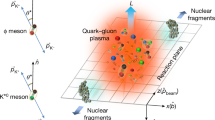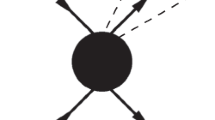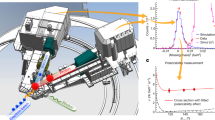Abstract
In recent observations with the photographic plate method, Lattes, Muirhead, Occhialini and Powell1 have given direct evidence of cosmic ray mesons with two different masses; furthermore, in some of their pictures the heavier meson stops in the emulsion and emits a lighter meson. At first one is tempted to identify these two mesons with the vector and pseudoscalar ones postulated in the Schwinger mixed meson theory of nuclear forces. Wentzel2 has, in fact, recently suggested that a vector meson can disintegrate into a pseudoscalar meson plus a photon, and one might conjecture whether this is not the process observed by the Bristol group1. According to calculations by Finkelstein3, this process has a lifetime of 4 × 10−18 sec. and would thus be too fast to be detected in the plate. Finkelstein's results show, in addition, that the contribution of the vector meson instability to the soft component of cosmic radiation would result from that process, that is, from photons and not from β-decay, which would then be slower by a factor of 1010.
This is a preview of subscription content, access via your institution
Access options
Subscribe to this journal
Receive 51 print issues and online access
$199.00 per year
only $3.90 per issue
Buy this article
- Purchase on Springer Link
- Instant access to full article PDF
Prices may be subject to local taxes which are calculated during checkout
Similar content being viewed by others
References
Lattes, C. M. G., Muirhead, H., Occhlalini, G. P. S., and Powell, C. F., Nature, 159, 694 (1947).
Wentzel, G., Rev. Mod. Phys., 19, 1 (1947).
Finkelstein, R. J., Phys. Rev., 72, 415 (1947).
Lattes, C. M. G., Occhialini, G. P. S., and Powell, C. F., Nature, 160, 453 (1947).
Hulthén, L., Rev. Mod. Phys., 17, 263 (1945).
See Corben, H. C., and Corben, M., Phys. Rev., 72, 526 (1947). Lopes, J. L., An. Acad. Bras. Ci., in the press.
Hanstein, H. B., Phys. Rev., 59, 489 (1941).
Author information
Authors and Affiliations
Rights and permissions
About this article
Cite this article
LOPES, J. Meson Decay and the Theory of Nuclear Forces. Nature 160, 866–867 (1947). https://doi.org/10.1038/160866c0
Issue Date:
DOI: https://doi.org/10.1038/160866c0
Comments
By submitting a comment you agree to abide by our Terms and Community Guidelines. If you find something abusive or that does not comply with our terms or guidelines please flag it as inappropriate.



